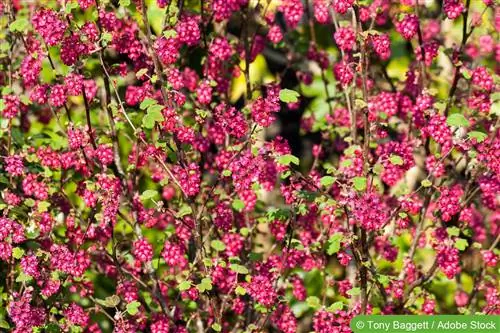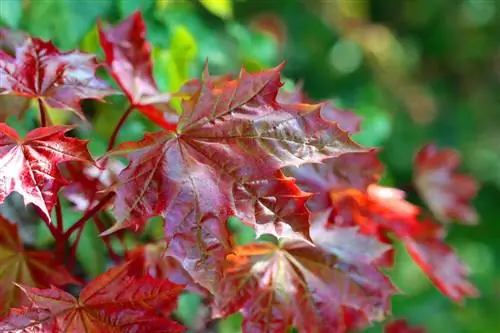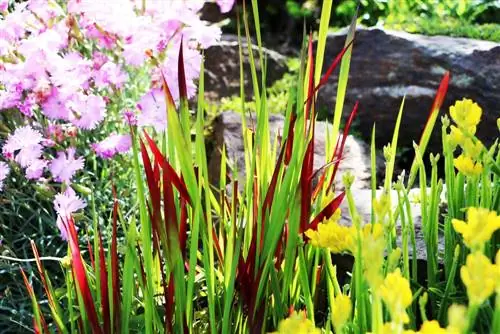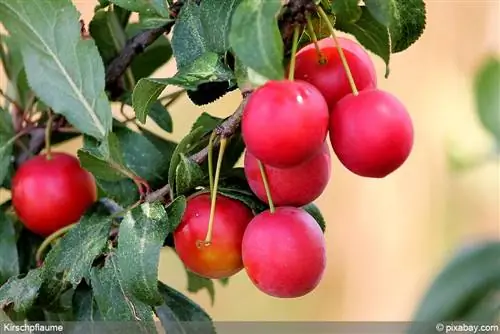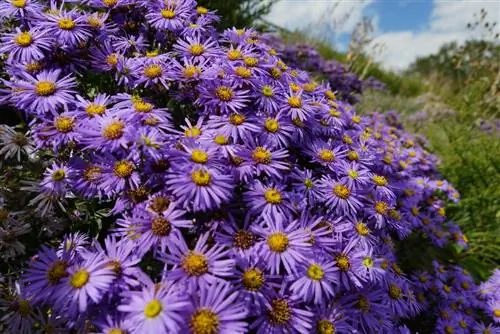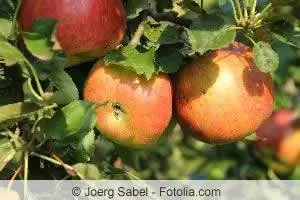- Author admin [email protected].
- Public 2023-12-17 03:39.
- Last modified 2025-06-01 06:48.
The bloodcurrant originally comes from North America. Therefore, she copes well with the German weather. Their distribution area extends to California. It belongs to the gooseberry family. According to the Latin name “ribes”, the blood currant is one of the currants. The bright red flowers make the bloodcurrant a decorative ornamental shrub. Although their berries are edible, they have little taste.
In addition to forsythia, ornamental currants are among the most popular early bloomers. Insects use the nectar as a source of food after the long winter. Bumblebees in particular, which end their hibernation during the flowering period, like to use the food supply and carry out the cross-pollination required for fruit formation.
Appearance
The ornamental shrub grows between one and four meters high. It is densely branched with reddish-brown bark and hairy twigs. The branches are slightly curved. The leaves of the bloodcurrant are three to five lobed, rounded and each five to ten centimeters large. They have a dark green, softly hairy upper surface with clearly visible leaf veins. The leaves form a dense foliage and have an aromatic scent. The flowers of the bloodcurrant hang in long clusters. There can be up to 20 flowers on one cluster. They appear in March, long before the leaves begin to sprout. The flowering period lasts until May/June. After flowering, the small black berries, around one centimeter in diameter, appear.
Tip:
If you leave the berries on the bush, then you are doing the garden birds a favor, because the berries have little flavor as food.
Location
The ornamental currant Ribes sanguineum thrives best in a warm, sunny spot, full sun or half shade. Tip: A sheltered location promotes early sprouting of the decorative inflorescences.
Substrate & Soil
The ornamental shrub thrives in normal, well-drained garden soil. The surface should not be too dry. Normal, permeable garden soil is perfect. Waterlogging and heavy clay soils are less suitable. In the first year, the shrub needs to be watered regularly. Later, natural precipitation is sufficient for irrigation.
Best planting time
The ornamental shrubs are planted until the first frost or in early spring. Two to two plants are recommended per square meter. The growth per year is 10-15 cm, except for fast-growing varieties.
Tip:
Add a scoop of compost to the planting hole for vigorous growth.
Fertilize
The bloodcurrant is very undemanding. Horn shavings promote the abundance of flowers through an additional dose of nitrogen. Coffee grounds and regular fertilization with garden compost are suitable natural fertilizers.
Tip:
Bark mulch or a cover of mulch keeps the warmth in the ground, which the bloodcurrant loves so much.
Cutting
Specific pruning promotes flowering, even if pruning is not absolutely necessary. When pruning, the shrub's bushy character should be retained. Pruning should be done after flowering:
- shorten long shoots by a third above an outward-facing eye
- cut off dried shoots close to the trunk
- Branches that grow inwards are completely removed
- Cut off water shoots at the base
- remove vertical secondary shoots to the main shoot
Tip:
A radical rejuvenation cut is not successful on the bloodcurrant!
Propagate
As with all currant bushes, there are several ways to propagate Ribes sanguineum. Like the strawberry, the ornamental currant can be propagated by planting plants. To do this, a one-year-old shoot is pulled to the ground in summer and covered with earth and stones. The shoot tip must protrude from the ground. The shoot needs to be watered regularly. The following spring the sinker has formed enough roots of its own. It is separated from the mother plant and planted in another location.
Tip:
Score the sinker in a few places before covering it with soil. The roots form more easily there.
Another method is to propagate through cuttings: This involves cutting off a he althy one-year-old shoot and cutting it into pieces about 10 to 20 cm long. There should be at least one bud at the top and bottom of each section. These sections are placed in potting soil in pots or directly into the garden soil so that only a quarter to a third of their length protrudes from the soil. Roots are then formed from the lower buds instead of new shoots. However, it is important to ensure that the cuttings are not turned when planting so that they do not end up upside down.
The pots with the cuttings should then be placed in a shady and cool place so that the cuttings sprout in spring. In the garden, the cuttings are placed outdoors in a protected place and can be dug up again later. The new plants are then moved to the correct location in autumn or spring of the following year.
Wintering
In autumn, the ornamental shrub sheds its orange-colored autumn leaves. The bloodcurrant is frost-tolerant and does not require winter protection.
Decorative plant groups
The decorative red flower decorations in spring can be complemented with yellow and blue tones. Typical representatives of these are crocuses, daffodils, forsythia, hyacinths, spring anemones and the white March cup. A blue-flowering ground cover is the low forest memorial. After flowering, the ornamental shrub is covered in a dense green foliage. It forms a suitable framework for blooming summer flowers and perennials of every color.
Frequently asked questions
What varieties of the ornamental currant Ribes sanguineum are there?
- Ornamental currant Ribes sanguineum King Edward VII with rich red flower clusters, blooms earliest
- Bloodcurrant Ribes sanguineum Atrorubens with bright red flower clusters, also suitable as a hedge plant.
- Ornamental currant Ribes sanguineum Snowflame with two-tone flowers in white and red, strongly fragrant, container plant
- Ornamental currant Ribes sanguineum Pulborough Scarlet with dark red flowers with a white center, fast growing
- Ornamental currant Ribes sanguineum White Icicle with white flowers and heart-shaped leaves
How is the bloodcurrant used in the garden?
The dark red flowers enhance the delicate spring blossoms. The shrub is suitable as a solitary plant, hedge plant and for group plantings. The bloodcurrant is suitable for waysides and borders and is a decorative eye-catcher in extensive parks. The ornamental currant is a deciduous tree. Nevertheless, the dense growth still provides sufficient privacy.
What diseases are there?
The shrub is resistant to fungi and bacteria. Yellow and wilted leaves can be caused by too much or too little moisture. If flower abundance decreases, the cause may be a lack of phosphorus, potassium or nitrogen. Hedge plants are sensitive to de-icing s alts. These lead to leaf damage. The leaf drop disease (brown spots) and the currant aphid (wilted leaves) cause damage to the leaves.
What you should know about the bloodcurrant in brief
The ornamental currant is one of the first signs of spring, blooming very early and bringing color to the still bare landscape. As early as April, when the leaves emerge, it produces abundant pink or red flowers that hang on large clusters. The ornamental currant is also traded under the name blood currant and originally comes from North America. The varieties of this plant are deciduous and hardy shrubs that grow compact and upright, reaching a width of up to 150 cm and a height of up to two meters. Such a bush grows up to 40 cm per year. In addition to the flowers, the leaves also have a light and pleasant scent.
Care
- The ornamental currant is happy with normal garden soil and thrives best in a sunny or partially shaded location.
- It can be planted as a solitary plant, but also as a hedge plant. For a hedge, two to three plants should be used per meter.
- If you want it to be really dense, otherwise you can plant it at larger intervals.
- An ornamental currant is absolutely hardy and therefore does not need any protection.
- The ornamental currant primarily needs nitrogen and phosphorus to bloom.
- A lack of flowering could indicate a deficiency, so appropriate fertilization may be helpful.
By the way: From July onwards, small blue-black berries form, which are usually surrounded by a whitish frost. They are edible, but do not have the same good taste as normal currants.
Cutting & timing
- A smaller pruning, i.e. up to a third of the height, is best done after flowering, i.e. in the period from May to June.
- This promotes flower formation the following year.
- Severe pruning, on the other hand, should be done earlier in the year, ideally in February.
- Then, however, it may be that the bush will not bloom again until the following year.

